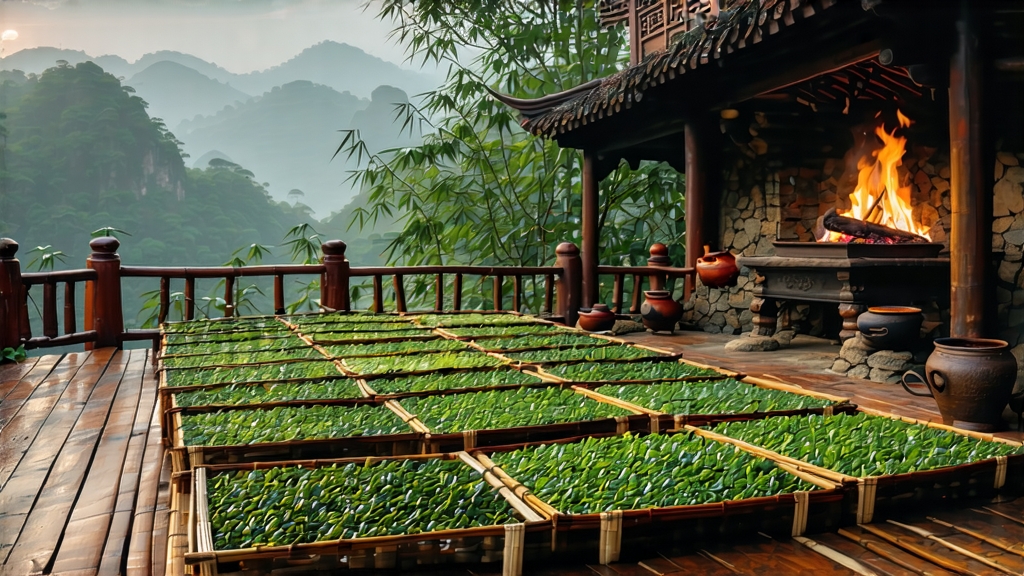
If every cup of black tea on earth could trace its family tree, the roots would plunge into the rocky soil of Tongmu Guan, a tiny protected village tucked high in China’s Wuyi Mountains. There, sometime around the mid-17th century, a serendipitous twist of timing, firewood shortage, and military urgency created the first deliberately smoked black tea in history. Locals call it Zheng Shan Xiao Zhong; the outside world knows it as Lapsang Souchong. More than a curiosity, it is the primogenitor of all subsequent black teas, the prototype that taught Europe what “bohea” tasted like and launched an oceanic trade worth its weight in silver. To understand Lapsang Souchong is to hold a living artifact—aromatic, sweet, and still gently smoldering four centuries later.
History: From War Camps to London Drawing Rooms
The most repeated origin tale begins in 1646 when Qing army units passed through Tongmu Guan during the tumultuous transition from Ming to Manchu rule. Farmers, already behind schedule with their spring green tea, hastened drying by firing the leaves over fresh pine boughs. The resulting dark, resinous tea traveled with the soldiers to regional markets, where Dutch traders bought it as “bohea” (a corruption of “Wuyi”) and shipped it to Amsterdam and London. British consumers adored the assertive campfire note; by 1669 the East India Company listed “Souchon” (a phonetic stab at “Xiao Zhong”) among its most valuable cargoes. Within fifty years bohea constituted 80 % of the tea drunk in England, paid for with opium and New World silver, and planted the commercial seeds for Indian and Ceylon black teas that would later eclipse their Chinese ancestor.
Terroir: Why Only 60 km² Can Make True Zheng Shan
Chinese law draws a tight protective circle around 680 hectares of core territory—Tongmu Guan and four neighboring hamlets—where the original gene pool of wild-type Xiao Zhong tea trees, mineral-rich latosol, and perpetual mist converge. Elevation (600–1 200 m), diurnal swings of 15 °C, and 85 % humidity slow leaf growth, concentrating sugars, amino acids, and volatile oils that later absorb pine smoke with uncanny fidelity. Step outside this micro-zone and the same craft produces merely “waishan” (outside-mountain) tea, flatter in fragrance and shorter on the finish. Thus every authentic Lapsang Souchong is simultaneously a cultivar, a process, and a postcode.
Cultivars: Three Clans Under One Smoke
Although the word “Souchong” once referred to the fifth and largest leaf plucked from a shoot, modern standards focus on cultivar rather than leaf position. The three registered varieties grown inside the core zone are:
- Cai Cha (mixed heirloom bushes, 60 % of plantings) – small leaves, high aromatics, classic dried-longan sweetness.
- Bei Dou #1 (a Wuyi rock-tea clone transplanted in the 1980s) – thicker cuticle, stands up to heavier smoke, yields a maltier liquor.
- Jin Guan Yin (a cross between Huang Jin Gui and Tie Guan Yin) – floral DNA that marries surprisingly well with resin, giving a honey-lavender top note found in top-grade “unsmoked” versions.
Farmers harvest only in late April and early May, waiting until two leaves and a bud are fully unfurled yet still tender enough to twist without tearing.
Craft: The Eight-Step Pine Ballet
Authentic production follows a choreography unchanged since the Qing dynasty, performed entirely by hand and nose.
- Plucking – dawn pick, baskets lined with bamboo leaves to prevent bruising.
- Withering – 8–10 hours on bamboo racks suspended over semi-damp mats; moisture drops from 75 % to 58 % while grassy volatils drift away.
- Rolling – 45 minutes of light pressure to rupture 30 % of cell walls; the goal is strip-shape rather than pellet.
- Fermentation – 3–4 hours in wooden troughs lined with wet cloth; temperature held at 24 °C, turning every 30 minutes until leaf edge turns chestnut.
- First drying – “mao hong” pass: